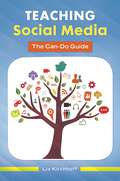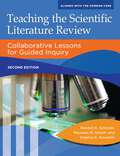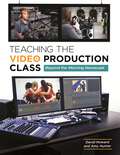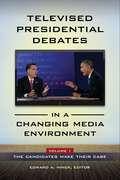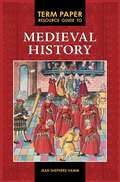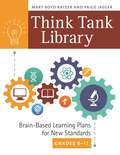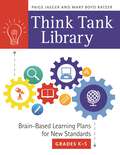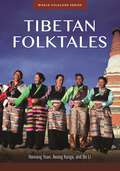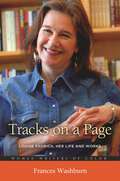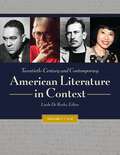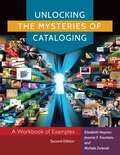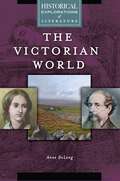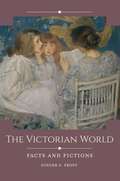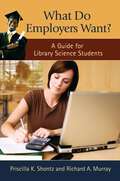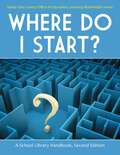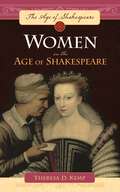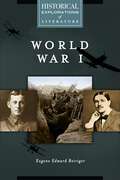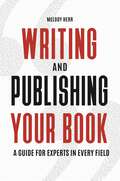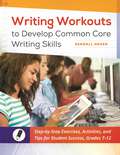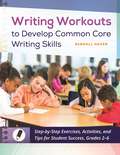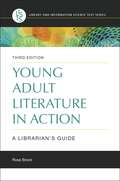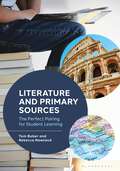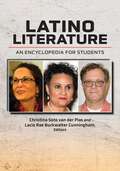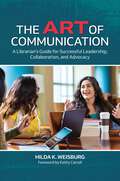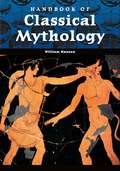- Table View
- List View
Teaching Social Media: The Can-Do Guide
by Liz KirchhoffLibrarians who want to begin, expand, or improve their programs on teaching social media to adults and teens will find this guide invaluable.Sharing social media expertise with library clientele is a natural way for libraries to support their communities—and increase their relevance. This book provides a roadmap for librarians who wish to offer this service but need to brush up on their own social media skills or learn how to cover the topics in a classroom situation.Although there are many books on social media, this volume is unique because it presents complete teaching scripts that can be adapted for various classroom situations along with general guidelines and tips. You'll find general advice on social media as well as suggestions for getting support for the program, creating a syllabus tailored to community needs, and planning class format and logistics. Entire chapters cover Twitter, Facebook, LinkedIn, Foursquare, Pinterest, Yelp, and Google+, explaining how these sites work and how to use them to your advantage, as well as some of the privacy and safety concerns surrounding them and how they are trending. Class variations such as Twitter for Business and How to Plan Your Trip Online are also discussed, as are other classes to consider—for example, Tumblr and Instagram—and how to develop them.
Teaching the Scientific Literature Review: Collaborative Lessons for Guided Inquiry (Libraries Unlimited Guided Inquiry)
by Randell K. Schmidt Maureen M. Smyth Virginia K. KowalskiAn essential resource for teachers and librarians who work with students in the later high school years through college and graduate school levels, this book explains and simplifies the scholarly task of researching and writing a scientific literature review.This thoroughly updated and revised follow-up to the popular text Lessons for a Scientific Literature Review: Guiding the Inquiry is designed for pre-collegiate and early collegiate educators in the sciences, high school and college librarians, curriculum directors and common core supervisors, school district leaders, and principals. The book provides step-by-step guidance on instructing students how to perform the necessary research and successfully integrate newly acquired information into a high-quality final product.In addition, you'll find an emphasis on using quantitative science research reports as well as white papers discussing more theoretical science topics, a student timeline for assignments, and a handout specifically for students working on writing a scientific literature review. More than 20 workshops/lessons that are aligned to standards dealing with digital literacy, information handling, research, and textual interpretations and representation are provided. The book allows you to easily adapt it for use of investigation of subjects in the humanities, and for the teaching of an extended essay.
Teaching the Video Production Class: Beyond the Morning Newscast
by David Howard Amy HunterThis guidebook is a must-have resource for anyone teaching a television production class or running a morning news show at the elementary, middle, or high school level.Teaching a television production class is a real challenge, especially when working with the typical budget and time limitations of most elementary, middle, or high school curricula. Beyond the technical aspects of teaching this subject, what is the best way to keep students engaged and challenged while teaching them skills that will help make them college and career ready? Spanning lesson plans, video production activities, assessment, and more, this book supplies a comprehensive, step-by-step guide to teaching a television production class, using whatever equipment is readily available. It focuses on the critical aspects of how to teach television production and organize lessons, rather than the quickly evolving details of what equipment or editing software to use. The authors also provide lessons on creating and executing a daily newscast show, how to evaluate that show and collect school-wide data for further evaluation and improvement, and how to archive and mount these productions on the school website.
Televised Presidential Debates in a Changing Media Environment [2 volumes]: [2 volumes]
by Edward A. HinckThis two-volume set examines recent presidential and vice presidential debates, addresses how citizens make sense of these events in new media, and considers whether the evolution of these forms of consumption is healthy for future presidential campaigns—and for democracy.The presidential debates of 2016 underscored how television highlights candidates' and campaigns' messages, which provide fodder for citizens' widespread use of new media to "talk back" to campaigns and other citizens. Social media will continue to affect the way that campaign events like presidential debates are consumed by audiences and how they shape campaign outcomes. This two-volume study is one of the first to examine the relationship between debates as televised events and events consumed by citizens through social media. It also assesses the town hall debate format from 1992 to 2016, uses the lens of civil dialogue to consider how citizens watch the debates, and considers the growing impact of new media commentary on candidate images that emerge in presidential and vice presidential debates.Televised Presidential Debates in a Changing Media Environment features contributions from leading political communication scholars that illuminate how presidential debates are transforming from events that are privately contemplated by citizens, to events that are increasingly viewed and discussed by citizens through social media. The first volume focuses on traditional studies of debates as televised campaign events, and the second volume examines the changing audiences for debates as they become consumed and discussed by viewers outside the traditional channels of newspapers, cable news channels, and campaign messaging. Readers will contemplate questions of new forms, problems, and possibilities of political engagement that are resulting from citizens producing and consuming political messages in new media.
Term Paper Resource Guide to Medieval History (Term Paper Resource Guides)
by Jean Shepherd HammHelp students get the most out of studying medieval history with this comprehensive and practical research guide to topics and resources.Term Paper Resource Guide to Medieval History brings key historic events and individuals alive to enrich and stimulate students in challenging and enjoyable ways. Students from high school to college will be able to get a jump start on assignments with the hundreds of term paper projects and research information offered here. The book transforms and elevates the research experience and will prove an invaluable resource for motivating and educating students. Each event entry begins with a brief summary to pique interest and then offers original and thought-provoking term paper ideas in both standard and alternative formats that often incorporate the latest in electronic media, such as the iPod and iMovie. The best primary and secondary sources for further research are annotated, followed by vetted, stable website suggestions and multimedia resources, usually films, for further viewing and listening.
Think Tank Library: Brain-Based Learning Plans for New Standards, Grades 6–12
by Mary Boyd Ratzer Paige JaegerTransform your library into a "think tank" by helping teachers create an active learning environment in which students question, investigate, synthesize, conclude, and present information based on Common Core standards.The rigors of today's mandated academic standards can repurpose your library's role as a steward of the Common Core State Standards (CCSS) at your school. Created for teachers of grades 6 through 12, this guide will help you help present exciting, field-tested lessons that address developmental steps and individual differences in key competencies in the CCSS. Authors and educators Mary Ratzer and Paige Jaeger illustrate how brain-based learning helps students become deep, critical thinkers, and provide the lesson plans to coax the best thinking out of each child.This tool book presents strategies to help learners progress from novice to expert thinker; challenge students with questions that lead to inquiry; incorporate "rigor" into lessons; and use model lesson plans to change instruction. Beginning chapters introduce the basics of instruction and provide ideas for expert cognitive growth of the brain. Sample lessons are aligned with key curriculum areas, including science, social studies, music, art, and physical education.
Think Tank Library: Brain-Based Learning Plans for New Standards, Grades K–5
by Paige Jaeger Mary Boyd RatzerTransform your library into a "think tank" by helping teachers create an active learning environment in which students question, investigate, synthesize, conclude, and present information based on Common Core standards.The rigors of today's mandated academic standards can repurpose your library's role as a steward of the Common Core State Standards (CCSS) at your school. This guide will help you help teachers present exciting, field-tested lessons for elementary grades K through 5, addressing developmental steps and individual differences in key competencies in the CCSS. Authors and educators Mary Ratzer and Paige Jaeger illustrate how brain-based learning helps students become deep, critical thinkers and provide the lesson plans to coax the best thinking out of each child.This tool book presents strategies to help learners progress from novice to expert thinker; challenge younger students with questions that lead to inquiry; incorporate "rigor" into lessons; and use model lesson plans to change instruction. Beginning chapters introduce the basics of instruction and provide ideas for expert cognitive growth of the brain. Sample lessons are aligned with key curriculum areas, including science, social studies, music, art, and physical education.
Tibetan Folktales (World Folklore Series)
by Haiwang Yuan Awang Kunga Bo LiThis collection of folktales provides readers with an extensive overview of the breadth of Tibetan culture, revealing the character of the region and its people as well as their traditional customs and values.Most Westerners are unlikely to travel to the mountainous region of East Asia and experience the Tibetan people and their culture directly. This book provides a way to experience and learn about this remote nation through carefully selected Tibetan folktales that provide readers with a unique glimpse into Tibet's culture, its people, and the land itself through the window of folklore. Providing a unique resource that can serve both as a storytime aid for educators who work with primary school students and a valuable reference for Eastern folklorists, Tibetan Folktales contains more than 30 traditional Tibetan stories that give readers a taste of the land, people, culture, history, religion, and psyche of this remote country. The tales are gathered from contemporary Tibetan storytellers and translated from written sources to represent the rich oral and written literary tradition of Tibet's culture. In addition, the book supplies tutorials for Tibetan crafts and games, a sample of recipes, and photographs and illustrations that create a multidimensional experience of Tibetan culture.
Tracks on a Page: Louise Erdrich, Her Life and Works (Women Writers of Color)
by Frances WashburnThis book details the intersections between the personal life and exceptional writing of Louise Erdrich, perhaps the most critically and economically successful American Indian author ever.Known for her engrossing explorations of Native American themes, Louise Erdrich has created award-winning novels, poetry, stories, and more for three decades. Tracks on a Page: Louise Erdrich, Her Life and Works examines Erdrich's oeuvre in light of her experiences, her gender, and her heritage as the daughter of a Chippewa mother and German-American father.The book covers Erdrich from her birth to the present, offering fresh information and perspectives based on original research. By interweaving biography and literary analysis, the author, who is herself Native American, gives readers a complete and nuanced understanding of the ways in which Erdrich's identity as a woman and an American Indian have influenced her life and her writing. Tracks on a Page is the first, book-length work to approach Erdrich and her works from a non-Euro-Western perspective. It contextualizes both life and writing through the lenses of American Indian history, politics, economics, and culture, offering readers new and intriguing ways to appreciate this outstanding author.
Twentieth-Century and Contemporary American Literature in Context [4 volumes]: [4 volumes]
by Linda De RocheThis four-volume reference work surveys American literature from the early 20th century to the present day, featuring a diverse range of American works and authors and an expansive selection of primary source materials.Bringing useful and engaging material into the classroom, this four-volume set covers more than a century of American literary history—from 1900 to the present. Twentieth-Century and Contemporary American Literature in Context profiles authors and their works and provides overviews of literary movements and genres through which readers will understand the historical, cultural, and political contexts that have shaped American writing. Twentieth-Century and Contemporary American Literature in Context provides wide coverage of authors, works, genres, and movements that are emblematic of the diversity of modern America. Not only are major literary movements represented, such as the Beats, but this work also highlights the emergence and development of modern Native American literature, African American literature, and other representative groups that showcase the diversity of American letters. A rich selection of primary documents and background material provides indispensable information for student research.
Unlocking the Mysteries of Cataloging: A Workbook of Examples
by Elizabeth Haynes Joanna F. Fountain Michele ZwierskiIdeal for students and both beginning and practicing catalogers in public, school, and academic libraries, this updated workbook offers targeted, hands-on exercises that enhance understanding of description, classification, subject analysis, subject heading application, and MARC 21 subject analysis.Like the first edition, this updated workbook has a straightforward goal: to help expand and improve the effectiveness of library catalogs. It is designed to supplement existing textbooks by providing exercises in AACR2r and RDA description, classification, subject analysis, and MARC protocols. Particular attention is given to problems that may arise when cataloging books as well as multimedia combinations, 3-D items, toys, natural objects, maps, printed and performed music, bilingual materials, and electronic files. Through the exercises, you will better understand the overall process of cataloging an item and making a record, the application of RDA in producing records, the steps for cataloging new media, and the differences in records using RDA or AACR2r.To enhance the exercises, the workbook incorporates photographs of real materials and offers questions for consideration. There is also a companion website with enlargeable color graphics. The site provides complete answer records and additional indexes for instructors to use in selecting examples for specific elements in the record. For students, new or advanced, selected MARC answer records are included, as are special lists, forms, and indexes leading to the tools any cataloger will need.Student ResourcesExercisesThe images from the exercises in the book are included in this section in a larger format for closer examination. ExercisesMARC TemplateFor use in drafting cataloging records for all types of elements. MARC TemplateInstructor's ResourcesMARC and RDA answer records are provided to instructors upon request. Please contact CustomerService@abc-clio.com for more information.
The Victorian World: A Historical Exploration of Literature (Historical Explorations of Literature)
by Anne DeLongAn indispensable resource for readers investigating Victorian literature and culture, this book offers a comprehensive summary of the historical, social, political, and cultural contexts of Victorian England.The Victorian era was a time of great social, scientific, and cultural change. The literary works of that period reflect that change and help us to better understand the Victorian world. This book examines the historical, political, social, and cultural contexts of several important Victorian literary works: Jane Eyre,, by Charlotte Brontë; Wuthering Heights,, by Emily Brontë; A Tale of Two Cities,, by Charles Dickens; and several poems by Elizabeth Barrett Browning, including "The Cry of the Children," "The Runaway Slave at Pilgrim's Point," "A Curse for a Nation," and Aurora Leigh..The volume provides historical explanations, literary analyses, and cultural context for each literary work, including primary documents from the nineteenth century. Topics investigated include women's rights, workers' rights, education reforms, marriage laws, race relations, inheritance and heredity, and other issues concerning gender, race, and class in the nineteenth century. Readers will gain a greater understanding of these major literary works as well as their historical context.
The Victorian World: Facts and Fictions (Historical Facts and Fictions)
by Ginger S. FrostAn introduction to the myths and realities of the history of Victorian Britain, with accompanying primary sources.While the Victorian era captivates many today, much of what people believe about the Victorian world is actually false. This book looks at nine specific myths about Victorian Britain, explaining how the myths perpetuated and then showing why they are inaccurate. Coverage spans 1830–1914, from shortly before Victoria's reign to World War I.The book is organized in three sections, beginning with social issues, then cultural ones, and ending with politics and war. The social sections pull in the reader by discussing the most common myths about the Victorians—their sexual prudery, strict gender roles, and infamous views of the family—while offering counterpoints to the myths. The cultural section moves into humor, criminal justice issues, and race, and the political section caps the book with discussions of the Industrial Revolution, foreign affairs, and war. Included are a large number of primary source documents showing how the misconceptions became popular, along with evidence for what scholars now believe to be the truths behind the myths.
What Do Employers Want?: A Guide for Library Science Students
by Priscilla K. Shontz Richard A. MurrayA candid, comprehensive, and insightful explanation of what library school students need to do in order to maximize their chances of getting a professional position immediately after graduation.While library schools provide graduates with a solid understanding of library science concepts, many diploma holders have no clear plan for finding a desirable job with their knowledge The information in What Do Employers Want? A Guide for Library Science Students will be extremely valuable for students currently in Masters of Library Science program as well as recent recipients of MLS degrees, regardless of what kind of work environment they wish to work in.The book guides readers through the process of planning a job search step-by-step. Divided into two major sections—the student experience and the job search—the authors provide critical advice derived from their combined 30 years of real-world, in-the-field experience. Specific topics include choosing classes, gaining practical experience while in school, establishing a professional image, gaining skills that make applicants more marketable, writing effective resumes and cover letters, interviewing, and negotiating a job offer.
Where Do I Start?: A School Library Handbook
by Santa Clara County Office of EducationIf you're new to running a library or looking for a refresher, this book can serve as your first reference source for school library operation, providing overview information on a wealth of topics, lists of resources for more in-depth information, and coverage of current topics such as Web 2.0, fundraising, digital booktalks, and cybersafety.With the extreme budget cuts most school libraries are facing, professional development resources for library support staff that improve library management efficiency are in great demand. This popular handbook provides an overview of many topics related to school libraries, collecting a vast amount of information together in one volume with an extensive index and selected additional resources.Written in an accessible style, it provides a quick reference and overview information for the operation of school libraries that both experienced and new library staff will find useful. Designed to be read both cover-to-cover and utilized as a ready reference, the second edition of Where Do I Start?: A School Library Handbook has updated subject material that includes coverage of Web 2.0 applications, library web pages, reading books to students, digital storytelling, future trends in library automation, and more.
Women in the Age of Shakespeare (The Age of Shakespeare)
by Theresa D. KempThis book offers a look at the lives of Elizabethan era women in the context of the great female characters in the works of William Shakespeare.Like the other entries in this fascinating series, Women in the Age of Shakespeare shows the influence of the world William Shakespeare lived in on the worlds he created for the stage, this time by focusing on women in the Elizabethan and Jacobean eras in general and in Shakespeare's works in particular.Women in the Age of Shakespeare explores the ancient and medieval ideas that Shakespeare drew upon in creating his great comedic and tragic heroines. It then looks at how these ideas intersected with the lived experiences of women of Shakespeare's time, followed by a close look at the major female characters in Shakespeare's plays and poems. Later chapters consider how these characters have been enacted on stage and in film, interpreted by critics and scholars, and re-imagined by writers in our own time.
World War I: A Historical Exploration of Literature (Historical Explorations of Literature)
by Eugene Edward BeirigerFocusing on the war on the Western and Southern fronts and inclusive of material from all sides of the conflict, this book explores the novels and poems of significant soldier-writers alongside important contemporary historical documents.The literary works of the First World War are one of the richest sources we have for understanding one of the twentieth century's most significant conflicts. Not only do many of them have historical merit, but some were critically acclaimed by both contemporaries and subsequent scholars. For example, Henri Barbusse's Under Fire, one of the earliest novels of the war, won accolades in France and the respect of war poets Siegfried Sassoon and Wilfred Owen as well as novelists Erich Maria Remarque and Ernest Hemingway.This book examines these works and those of war poets Rupert Brooke and John McCrae and others, providing context as well as opportunities to explore thematic elements with primary source documents, such as diaries, letters, memoirs, newspaper and journal articles, speeches, and government publications. It is unique in its use of literary and historical sources as mediums by which to both better understand the literature of the war and use literature to better understand the war itself.
Writing and Publishing Your Book: A Guide for Experts in Every Field
by Melody Herr Ph.D.Are you ready to write your book? Partner with an experienced publisher, writing coach, and author and find out how to turn your research and scholarship into a book.This book is the next-best-thing to a personal writing coach. Drawing upon her own extensive experience as an author and publisher, Melody Herr guides the reader through every step of the writing and publishing process: constructing a table of contents, preparing a proposal, finding a publisher, negotiating a contract, drafting the manuscript, and marketing the finished product. Throughout, she offers proven strategies for producing a book that highlights its author's authoritative knowledge and writing skills. Unique among writing guides, Writing and Publishing Your Book: A Guide for Experts in Every Field acknowledges the reader's own expertise; speaks to researchers and scholars across the sciences, social sciences, and humanities; and provides information and guidance that will benefit junior authors as well as their more senior colleagues. By following these practical, step-by-step instructions, new authors will more easily liberate their own creativity while avoiding the many pitfalls that mire new writers, thereby maintaining momentum for a successful publication.
Writing Workouts to Develop Common Core Writing Skills: Step-by-Step Exercises, Activities, and Tips for Student Success, Grades 7–12
by Kendall HavenThis book is a "best of" collection of tips and exercises to help nurture young writers and strengthen core skills. Since each activity has been tried and tested in thousands of classrooms, you'll find successful methods for turning even the most reluctant students into effective, powerful writers.Writing proficiency is more important than ever, especially with the demands of standardized testing and the rigors of new standards impacting our schools. This classroom-tested manual, created from a combination of the author's extensive in-class experience and acclaimed research in neural science and developmental biology, addresses all facets of writing competency. The content links to common core curriculum elements in state language arts standards for every state.Written by experienced educator and author Kendall Haven, the work features 13 innovative writing tips and 30 engaging activities for helping students become better writers. The first part of the book covers writing hints and techniques, while the second half contains core content activities for coaxing the best writing out of your students. A short introductory section lays out the five steps of effective student writing. Lastly, the text reveals how teachers—even those from non-literary backgrounds—can successfully teach and grade writing.
Writing Workouts to Develop Common Core Writing Skills: Step-by-Step Exercises, Activities, and Tips for Student Success, Grades 2–6
by Kendall HavenThis book is a "best of" collection of tips and exercises to help nurture young writers and strengthen core skills. Since each activity has been tried and tested in thousands of classrooms, you'll find successful methods for turning even the most reluctant students into effective, powerful writers.Writing proficiency is more important than ever, especially with the demands of standardized testing and the rigors of new standards impacting our schools. This classroom-tested manual, created from a combination of the author's extensive in-class experience and acclaimed research in neural science and developmental biology, addresses all facets of writing competency. The content links to common core curriculum elements in state language arts standards for every state.Written by experienced educator and author Kendall Haven, the work features 13 innovative writing tips and 30 engaging activities for helping students become better writers. The first part of the book covers writing hints and techniques, while the second half contains core content activities for coaxing the best writing out of your students. A short introductory section lays out the five steps of effective student writing. Lastly, the text reveals how teachers—even those from non-literary backgrounds—can successfully teach and grade writing.
Young Adult Literature in Action: A Librarian's Guide (Library and Information Science Text Series)
by Rose BrockTaking a genre approach, this overview of young adult literature shows new librarians and library science students the criteria to use for selecting quality books, including recommended titles.This third edition of Young Adult Literature in Action draws on the success of the previous two editions authored by Rosemary Chance, updating and expanding on them to meet the needs of today's librarians and library science students. It includes a new focus on diverse books, LGBTQ+ selections, the role of book formats, and the relevance of librarians serving teen populations and is an ideal resource for teaching young adult literature courses.Organized by major genre divisions, this easy-to-use book includes new information on timely topics such as audio and e-books, accessible books, and graphic novels. Each chapter includes revised and updated information on collaborative activities, featured books, special topics and programs, selected awards and celebrations, historical connections, recommended resources, issues for discussion, author comments, and assignment suggestions. Further updates include citations of exemplary young adult books and award winners, references, websites, and a bibliography.
Literature and Primary Sources: The Perfect Pairing for Student Learning
by Tom Bober Rebecca NewlandEnrich student engagement and deepen learning with this guide to foolproof techniques and strategies to integrate primary sources and literature to benefit learners from kindergarten through high school.Readers of all ages experience literature in a different light when historical context is provided via primary sources. Literature, meanwhile, helps learners to uncover additional layers of meaning inherent in primary sources. Guided by best practices developed by the authors over years of working with both students and teachers, this book speaks to the countless opportunities for instructors to integrate related primary sources with the literature that students read in school classrooms-from historical fiction and poetry to graphic novels.
Latino Literature: An Encyclopedia for Students
by Christina Soto van der Plas and Lacie Rae Buckwalter CunninghamOffers a comprehensive overview of the most important authors, movements, genres, and historical turning points in Latino literature.More than 60 million Latinos currently live in the United States. Yet contributions from writers who trace their heritage to the Caribbean, Central and South America, and Mexico have and continue to be overlooked by critics and general audiences alike. Latino Literature: An Encyclopedia for Students gathers the best from these authors and presents them to readers in an informed and accessible way. Intended to be a useful resource for students, this volume introduces the key figures and genres central to Latino literature. Entries are written by prominent and emerging scholars and are comprehensive in their coverage of the 19th, 20th, and 21st centuries. Different critical approaches inform and interpret the myriad complexities of Latino literary production over the last several hundred years. Finally, detailed historical and cultural accounts of Latino diasporas also enrich readers' understandings of the writings that have and continue to be influenced by changes in cultural geography, providing readers with the information they need to appreciate a body of work that will continue to flourish in and alongside Latino communities.
The Art of Communication: A Librarian's Guide for Successful Leadership, Collaboration, and Advocacy
by Hilda K. WeisburgLibrarians will learn communication skills that help them develop as leaders, build community, and advocate for their libraries.Librarians understand the importance of making the value of the library known to stakeholders. In this informative and conversational book, Hilda K. Weisburg gradually builds librarians' communication skills, which are intrinsic to the success of library programs and services. Being able to effectively communicate as a sender and receiver of messages is a vital leadership skill, and librarians must master all the multi-faceted ways people exchange information in order to grow as leaders.Throughout the book, librarians will learn communication basics and the obstacles that interfere with successful communication. The chapters in part one detail the three components of communication; part two prepares librarians to cope with difficult communications; and part three gives librarians further techniques to ensure their messages are cohesive and strategic as they reach out to stakeholders.The book's goal is for librarians to feel confident about using their newly learned communication skills for advocacy. As their value to the library community grows, they will be able to strategically use the relationships their communications have built to create positive change.
Handbook of Classical Mythology (World Mythology)
by William F. HansenAn introduction to the mythological world of the Greeks and the Romans, combined with a chronology of myths and a dictionary of key characters, objects, and events.Handbook of Classical Mythology offers newcomers and long-time enthusiasts new ways to navigate the world of Greek and Roman myths. Written by a foremost mythologist, the book begins by exploring the sources and landscapes from which the myths emerged. It then provides a richly detailed timeline of mythic episodes from the creation of the cosmos to the end of the Heroic Age—plus an illustrated mythological dictionary listing every significant character, place, event, and object.Whether exploring the world that gave rise to ancient mythology or researching a specific piece of the whole, the handbook is the best introduction available to the extraordinary cast of these tales (gods, nymphs, satyrs, monsters, heroes) and the natural and supernatural stages upon which their fates are played out.
